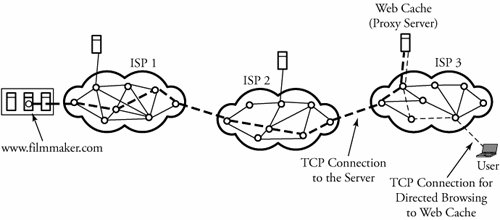Section 9.6. World Wide Web (WWW) and HTTP
9.6. World Wide Web (WWW) and HTTPApplication-layer software is the intelligence built for end servers. The World Wide Web (WWW), or simply Web , is a global network of servers linked by a common protocol allowing access to all connected hypertext resources. When a client host requests an object, a Web server responds by sending the requested object through browsing tools. A browser is a user agent displaying the requested Web page. The Hyper Text Transfer Protocol (HTTP) transfers that page at the application layer. HTTP uses TCP rather than UDP, since reliability of delivery is important for Web pages with text. The TCP connection-establishment delay in HTTP is one of the main contributing delay factors associated with downloading Web documents. HTTP is based on the client/server idea, having a client and a server program, both of which can be executed on different end systems. The communication is carried out through an exchange of HTTP messages. This protocol specifies the structure of these messages. For example, HTTP defines how a pair of client/server hosts should exchange messages. In this context, a Web page consists of files, such as Hypertext Markup Language (HTML) file or an image that can be addressed by a single uniform resource locator (URL). A URL is a global address of an HTML document and has two parts . The first part indicates what protocol is used, and the second part determines the IP address of the associated resource. 9.6.1. Web Caching (Proxy Server)An HTTP request from a user is first directed to the network proxy server , or Web cache . Once configured by the network, a browser's request for an object is directed to the Web cache, which must contain updated copies of all objects in its defined proximity. The main reason for Web caching is to reduce the response time for a user request. This benefit is much more obvious when the bandwidth to a requested server is limited because of traffic at certain hours of the day. Normally, each organization or ISP should have its own cache providing a high-speed link to its users. Consequently, it is to users' advantages that this rapid method of finding objects be available. This method of Internet access also reduces traffic on an organization's access link to the Internet. The details of Web caching are as follows : Begin Web Caching Algorithm
Figure 9.9 shows three Internet service providers (ISPs). A user in ISP domain 3 is browsing to find and watch an object named http://www.filmmaker.com in ISP domain 1. The request for this object is directed to the Web cache, shown by dashed lines. In this example, the Web cache has no record of the requested object and therefore is establishing another TCP connection to update its record. Figure 9.9. A user's browser requesting an object through the Web cache |
EAN: 2147483647
Pages: 211